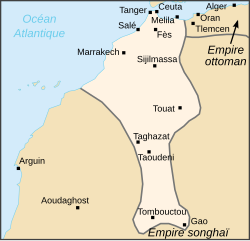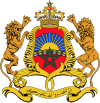Saadi Sultanate
Saadi dynasty of Magreb al Aksa السعديون (ar) | |||||||||||||||||
|---|---|---|---|---|---|---|---|---|---|---|---|---|---|---|---|---|---|
| (1509) 1554 – 1659 | |||||||||||||||||
|
Flag | |||||||||||||||||
 Extent of the Saadian empire during the reign of Ahmad al-Mansur | |||||||||||||||||
| Capital | Marrakech | ||||||||||||||||
| Religion | Sunni Islam | ||||||||||||||||
| Government | Sultanate | ||||||||||||||||
| Sultan | |||||||||||||||||
• 1509-1517 | Abu Abdallah al-Qaim | ||||||||||||||||
• 1655-1659 | Ahmad el Abbas | ||||||||||||||||
| History | |||||||||||||||||
• Established | 1509 | ||||||||||||||||
• Disestablished | 1659 | ||||||||||||||||
| |||||||||||||||||
The Saadi dynasty of Mareb (Arabic: سعديون) (in English also Saadite or Saadian, original name Bani Zaydan), began with the reign of Sultan Mohammed ash-Sheikh in 1554, when he vanquished the last Wattasids at the Battle of Tadla.
From 1509 to 1554 they had ruled only in the south of Morocco, officialized by the 1527 Treaty of Tadla. The Saadian rule ended in 1659 with the end of the reign of Sultan Ahmad el Abbas.
The Saadī family claimed descent from Muhammad through the line of Ali ibn Abi Talib and Fatima Zahra (Muhammad's daughter). The Saadi came from Tagmadert in the valley of the Draa River. The family's village of origin in the Draa was Tidzi (a qsar, some 10 km north of Zagora) [1]. They claimed sharifian origins through an ancestor from Yanbu and rendered Sufism respectable in Magreb. The name Saadi or Saadian derives from "sa'ada" meaning hapiness or salvation. Others think it derives from the name Bani Zaydan or that it was given to the Bani Zaydan (shurafa of Tagmadert) by later generations and rivals for power, who tried to deny their Hassanid descent by claiming that they came from the family of Halimah Saadiyya, Muhammad's wet nurse.[2] The most famous sultan of the Saadi was Ahmad al-Mansur (1578–1603), builder of the El Badi Palace in Marrakech and contemporary of Elizabeth I. One of their most important achievements was defeating the Portuguese at the Battle of Ksar El Kebir and defending the country against the Ottomans. Before they conquered Marrakech, they had Taroudant as their capital city.
The Saadian Tombs were rediscovered in 1917 and can be seen in Marrakech.
Rulers
Until 1554 only in Southern Morocco:
- Abu Abdallah al-Qaim (1509-1517)
- Ahmad al-Araj (1517-1544)
- Mohammed ash-Sheikh (1544-1557) (ruling all of Morocco after 1554)
- Abdallah al-Ghalib (1557–1574)
- Abu Abdallah Mohammed II (1574–1576)
- Abu Marwan Abd al-Malik I (1576–1578)
- Ahmad al-Mansur (1578–1603)
- Abou Fares Abdallah (born 1564) (r.1603–1608 in parts of Morocco)
1603-1659 the Saadian rulers of Morocco based in Marrakesh
- Zidan Abu Maali (r.1603–1627)
- Abu Marwan Abd al-Malik II (r.1627–1631)
- Al Walid ibn Zidan (r.1631–1636)
- Mohammed esh Sheikh es Seghir (r.1636–1655)
- Ahmad el Abbas (r.1655–1659)
1603-1627 the Saadian rulers based in Fes (with only local power)
- Mohammed esh Sheikh el Mamun (born 1560), (r.1604-1613)
- Abdallah II (r.1613-1623)
- Abd el Malek (r.1623-1627)
See also
References
- ^ The Saadian sultan Mohammed esh Sheikh es Seghir wrote in a letter to the a member of the Alaouite family (Moulay Mohammed ould Moulay Cherif ): "We are from Tidsi, one of the qsour of the Draa." (Nozhet el Hadi, p. 15). The geographical position of Tidzi is: Latitude: 30° 59' 52 N, Longitude: 7° 24' 49 W.
- ^ The use of Analogy and the Role of the Sufi Shaykh in Post-Marinid Morocco, Vincent Cornell, International Journal of Middle East Studies, vol. 15, no. 1 (feb, 1983), pp.67-93)
Further reading
- Rosander, E. Evers and Westerlund, David (1997). African Islam and Islam in Africa: Encounters Between Sufis and Islamists. C. Hurst & Co. Publishers. ISBN 1-85065-282-1
- History of Morocco
- Morocco in the Sixteenth Century. Problems and Patterns in African Foreign Policy by Dahiru Yahya, Canadian Journal of African Studies / Revue Canadienne des Études Africaines, Vol. 18, No. 1 (1984), pp. 252-253



